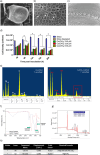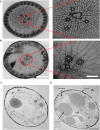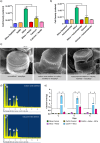Modification of Living Diatom, Thalassiosira weissflogii, with a Calcium Precursor through a Calcium Uptake Mechanism: A Next Generation Biomaterial for Advanced Delivery Systems
- PMID: 38758756
- PMCID: PMC11190972
- DOI: 10.1021/acsabm.4c00431
Modification of Living Diatom, Thalassiosira weissflogii, with a Calcium Precursor through a Calcium Uptake Mechanism: A Next Generation Biomaterial for Advanced Delivery Systems
Abstract
The diatom's frustule, characterized by its rugged and porous exterior, exhibits a remarkable biomimetic morphology attributable to its highly ordered pores, extensive surface area, and unique architecture. Despite these advantages, the toxicity and nonbiodegradable nature of silica-based organisms pose a significant challenge when attempting to utilize these organisms as nanotopographically functionalized microparticles in the realm of biomedicine. In this study, we addressed this limitation by modulating the chemical composition of diatom microparticles by modulating the active silica metabolic uptake mechanism while maintaining their intricate three-dimensional architecture through calcium incorporation into living diatoms. Here, the diatom Thalassiosira weissflogii was chemically modified to replace its silica composition with a biodegradable calcium template, while simultaneously preserving the unique three-dimensional (3D) frustule structure with hierarchical patterns of pores and nanoscale architectural features, which was evident by the deposition of calcium as calcium carbonate. Calcium hydroxide is incorporated into the exoskeleton through the active mechanism of calcium uptake via a carbon-concentrating mechanism, without altering the microstructure. Our findings suggest that calcium-modified diatoms hold potential as a nature-inspired delivery system for immunotherapy through antibody-specific binding.
Keywords: Thalassiosira weissflogii; antibody-binding delivery system; calcium uptake; chemical modification; diatoms.
Conflict of interest statement
The authors declare no competing financial interest.
Figures








Similar articles
-
Functionalization of the living diatom Thalassiosira weissflogii with thiol moieties.Nat Commun. 2013;4:2683. doi: 10.1038/ncomms3683. Nat Commun. 2013. PMID: 24177724
-
Integration of TiO2 into the diatom Thalassiosira weissflogii during frustule synthesis.Sci Rep. 2013 Nov 13;3:3205. doi: 10.1038/srep03205. Sci Rep. 2013. PMID: 24220344 Free PMC article.
-
Nature engineered diatom biosilica as drug delivery systems.J Control Release. 2018 Jul 10;281:70-83. doi: 10.1016/j.jconrel.2018.05.013. Epub 2018 May 14. J Control Release. 2018. PMID: 29772290 Review.
-
Modifying the thickness, pore size, and composition of diatom frustule in Pinnularia sp. with Al3+ ions.Sci Rep. 2020 Nov 11;10(1):19498. doi: 10.1038/s41598-020-76318-5. Sci Rep. 2020. PMID: 33177559 Free PMC article.
-
Diatom Silica for Biomedical Applications: Recent Progress and Advances.Adv Healthc Mater. 2018 Oct;7(19):e1800552. doi: 10.1002/adhm.201800552. Epub 2018 Aug 17. Adv Healthc Mater. 2018. PMID: 30118185 Review.
Cited by
-
Diatom-Based Artificial Antigen-Presenting Cells: A Novel Approach for Adaptive Immune Modulation.ACS Appl Mater Interfaces. 2025 Jul 2;17(26):37718-37734. doi: 10.1021/acsami.5c07766. Epub 2025 Jun 18. ACS Appl Mater Interfaces. 2025. PMID: 40530806 Free PMC article.
References
-
- Tramontano C.; Chianese G.; Terracciano M.; de Stefano L.; Rea I. Nanostructured Biosilica of Diatoms: From Water World to Biomedical Applications. Appl. Sci. 2020, 10 (19), 6811.10.3390/app10196811. - DOI
Publication types
MeSH terms
Substances
LinkOut - more resources
Full Text Sources
